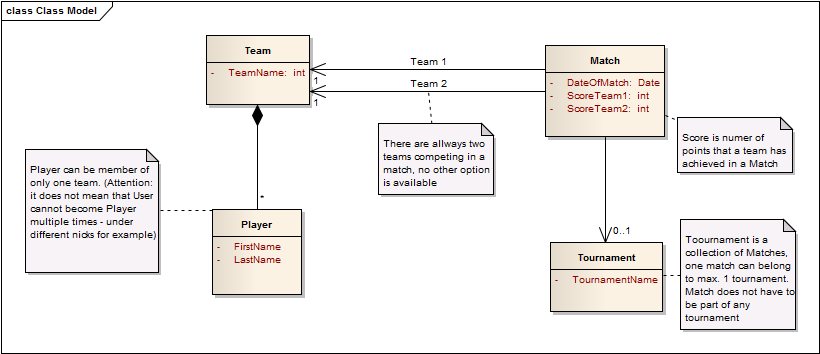I am designing a new application to track sports statistics with code-first migration. I have the bare minimum POCO setup. The problem is that I am not happy with the design specifically how the players, teams and tournaments are relating to each other.
I appreciate any comments and suggestions.
PlayerAccount class:
/// <summary>
/// Player account is a separate entity from the actual user account.
/// Player account allows a user to join teams and participate in a tournament.
/// </summary>
public class PlayerAccount
{
[Key]
public int Id { get; set; }
[Required]
public string FirstName { get; set; }
[Required]
public string LastName { get; set; }
/// <summary>
/// TournamentPlayerKeys tells us which team this player is competing with
/// in a certain tournament.
/// </summary>
public virtual ICollection<PlayerTeamKey> PlayerTeamKeys { get; set; }
public virtual ICollection<PlayerMatchStat> PlayerMatchStats { get; set; }
}
Team class:
using System.Collections.Generic;
using System.ComponentModel.DataAnnotations;
/// <summary>
/// Team can be formed by a single user or a group of user. You'll need a team to join a tournament.
/// A single user can form his own team.
/// </summary>
public class Team
{
[Key]
public int Id { get; set; }
[Required]
public string Name { get; set; }
public virtual ICollection<PlayerTeamKey> PlayerTeamKeys { get; set; }
public virtual ICollection<TeamTournamentKey> TeamTournamentKeys { get; set; }
}
Tournament class:
using System.Collections.Generic;
using System.ComponentModel.DataAnnotations;
/// <summary>
/// Tournaments are basically a collection of games in one event.
/// For example, Summer 2014 Basketball League.
/// </summary>
public class Tournament
{
[Key]
public int Id { get; set; }
[Required]
public string Name { get; set; }
public virtual ICollection<TeamTournamentKey> TeamTournamentKeys { get; set; }
public virtual ICollection<TournamentMatch> TournamentMatches { get; set; }
}
On a tournament there are multiple instances of matches (games):
/// <summary>
/// Match represents one occurence of a game in a league.
/// </summary>
public class TournamentMatch
{
[Key]
public int Id { get; set; }
[Required]
public int Tournament_Id { get; set; }
[ForeignKey("Tournament_Id")]
public virtual Tournament Tournament { get; set; }
public virtual ICollection<TournamentMatchResult> TournamentMatchResults { get; set; }
}
And of course we have multiple instances of match results in one match. The Score property determines who is the winner.
/// <summary>
/// This is the result of a league match.
/// </summary>
public class TournamentMatchResult
{
[Key]
public int Id { get; set; }
[Required]
public int Match_Id { get; set; }
[Required]
public int Team_Id { get; set; }
[Required]
public double Score { get; set; }
[ForeignKey("Match_Id")]
public virtual TournamentMatch TournamentMatch { get; set; }
[ForeignKey("Team_Id")]
public virtual Team Team { get; set; }
public virtual ICollection<PlayerMatchStat> PlayerMatchStat { get; set; }
}
I have a multipart key that creates the relationship between a player and a team:
/// <summary>
/// This is a multipart key class that defines a player as part of a team.
/// Mind the naming convension, from smaller entity to a bigger entity; Player > Team.
/// </summary>
public class PlayerTeamKey
{
[Required]
public int PlayerAccount_Id { get; set; }
[Required]
public int Team_Id { get; set; }
[ForeignKey("PlayerAccount_Id")]
public virtual PlayerAccount Player { get; set; }
[ForeignKey("Team_Id")]
public virtual Team Team { get; set; }
}
And I have another like that for team and tournament:
/// <summary>
/// This is a multipart key class that is a combination of a team id and a tournament id.
/// This basically tells us that the team with the given id is going to participating on a tournament with the given id.
/// </summary>
public class TeamTournamentKey
{
[Required]
public int Team_Id { get; set; }
[Required]
public int Tournament_Id { get; set; }
[ForeignKey("Team_Id")]
public virtual Team Team { get; set; }
[ForeignKey("Tournament_Id")]
public virtual Tournament Tournament { get; set; }
}









